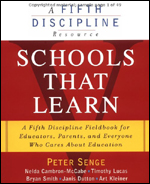 (Reprinted with permission from the Harvard Educational Review, written by Tom Buffett.)
(Reprinted with permission from the Harvard Educational Review, written by Tom Buffett.)
Many policymakers and educational practitioners discuss “capacity building” as a treatment of sorts: building capacity around data analysis, strategic planning, or curriculum alignment are a few of the interventions designed to assist schools in developing the skills and knowledge necessary to improve. But what is capacity building? How do schools actually develop capacity? Capacity to do what?
In Schools that Learn Peter Senge argues that teachers, administrators, and other members of school communities must learn how to build their own capacity; that is, they must develop the capacity to learn. From Senge’s perspective, real improvement will only occur if the people responsible for implementation design the change itself: “It is becoming clear that schools can be recreated, made vital, and sustainably renewed not by fiat or command, and not by regulation, but by taking the learning orientation” (emphasis in original). Senge, author of the best-selling The Fifth Discipline, has written a highly readable companion book directly focused on education. Individuals familiar with his earlier work will immediately recognize the five skills or disciplines at the heart of the learning orientation he proposes: developing personal mastery, creating shared mental models, establishing a shared vision, engaging in team learning, and thinking systemically.
Collectively, these five disciplines represent the component skills underlying the learning process. According to Senge, if an individual, group, or organization develops the capacity to do each of the disciplines well, they will have become proficient in learning itself.
Schools that Learn is a resource book, and as such includes numerous exercises, techniques, and stories designed to help the people who work with and within schools learn how to develop their capacity to find solutions to the problems that thwart improvement. This volume is not designed to be read cover to cover; rather, Senge organizes the book in “three nested systems of activity”: the classroom, the school, and the school community. Within each section, Senge and some 113 contributing authors offer anecdotes about systemic thinking, exercises designed to facilitate learning the disciplines, and lists of resources to connect the reader to other relevant ideas.
Senge employs “margin icons” to help readers understand the material and enable quick reference to related ideas. Icons are used to denote individual and team exercises; the etymology of key words; practical techniques for learning the disciplines; lists of relevant books, articles, and videos; and opportunities for reflection. Three elements of “organizational architecture” are also indicated with icons: guiding ideas or principles, innovations in organizational design, and the theoretical underpinnings of the techniques for learning the five disciplines. These markings are highly useful in orienting the reader to help see the connections between the nested systems and find illustrative examples of the concepts that are explain-ed. As an aid to systemic thinking, including such iconography is philosophically congruent with Senge’s overall approach: it provides substantive scaffolding to facilitate practical attention to details while keeping in mind the complexity of reform (e.g., the interconnectedness of policies and practice, of school culture and school performance, etc.).
Senge makes a powerful argument regarding the need for a systems approach and learning orientation by introducing Schools that Learn with a historical perspective on educational systems. Specifically, he details “industrial age” assumptions about both learning—that “children are deficient and schools should fix them,” that learning is strictly an intellectual enterprise, that everyone should learn in the same way, that classroom learning is distinctly different than that occurring outside of school, and that some kids are smart while others are not—and schools—schools “are run by specialists who maintain control;” knowledge is inherently fragmented; schools teach some kind of objective truth; and “learning is primarily individualistic and competition accelerates learning.” These assumptions about learning and the nature and purpose of schools reflect deeply embedded cultural beliefs that must be considered, and in many cases directly confronted, if schools are to develop the learning orientation necessary for improvement.
Importantly, Senge offers no prescriptions for success. He believes that, in order to be effective, solutions must be developed locally, not by “specialists” who sit far outside classroom and school walls. Instead, Senge offers a set of principles and activities, along with illustrative stories, designed to engage the reader in a process of learning and reflection. While some may be frustrated by the lack of specifics, not offering easy answers is precisely Senge’s point: practitioners must experience the messiness of change in order for real improvement to occur. Others have called Senge’s vision for organizational improvement idealistic and unsupported by external research and evaluation. Schools that Learn offers no specific answers to such critics, but rather provides a much needed resource book for those working to “build capacity” in schools. Policymakers at all levels, school principals, teachers, parents, and students can benefit from the ideas, stories of inspiration, and many tools that are included. In Schools that Learn, Senge complexifies and scaffolds the conversation regarding what building capacity looks like in schools and offers practical suggestions for how to begin to do it.